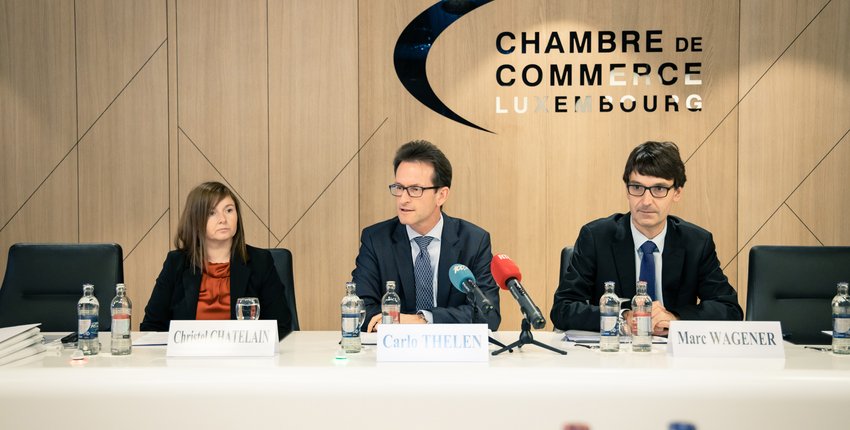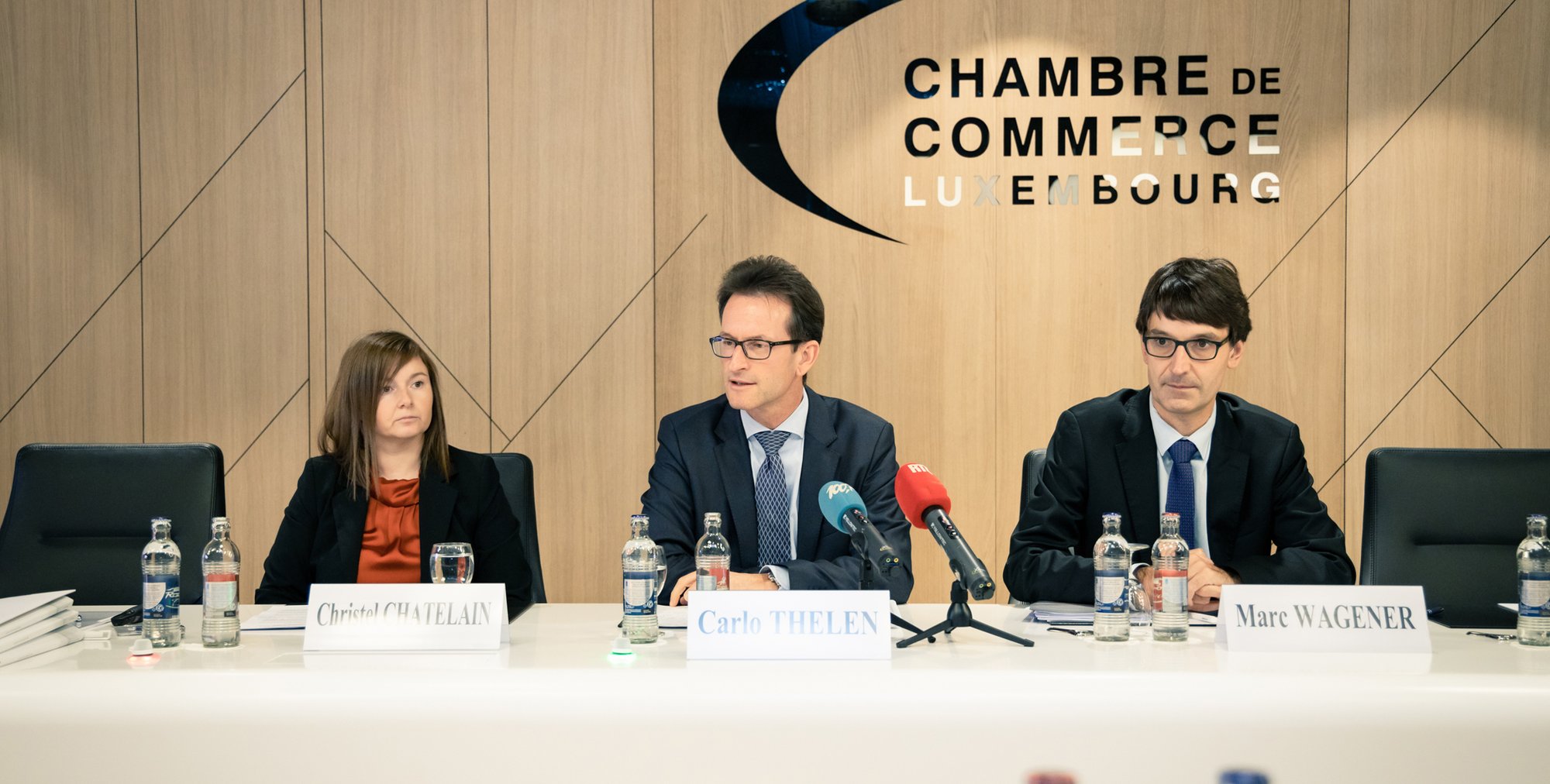
Budgetary opinion of the Chamber of Commerce

On 14 October, the government submitted not only the draft budget for 2020, but also a multi-year project covering the years 2019 to 2023. The Chamber of Commerce once again welcomes this work that extends beyond the short term. However, beyond the rhetoric, it would like to see successive budgets provide more of an opportunity to embrace the long-term development of Luxembourg’s economy and society.
The long-term dimension should first of all provide more support for the draft budget itself, with a real analysis of the sustainability of Luxembourg's public finances. The draft multi-year budget, in particular, should be a long-term launch pad (including the sovereign wealth fund, the costs of ageing, 10 or 20-year public investment planning, etc.), rather than a simple extension of the draft budget for the coming year based on a rather disparate list of budget articles that still do not fully meet the requirements of the promising ‘budgetary reform’.
A long-term vision also means taking into account as of now, in policies for which the budget is only one of the provisions, requirements for more qualitative growth. Luxembourg needs sustained growth, if only to ensure the financing of its social security systems. However, the latter cannot forever be accompanied by an exponential increase in the labour force, particularly because of the future decline in the number of people of working age in the Greater Region. Growth must also be resource-efficient and accompanied by increased transport and housing.
The Chamber of Commerce welcomes the surplus recorded by the central administration in 2018, amounting to EUR 263 million, and companies have contributed significantly to this result thanks to a particularly solid local income tax since 2016. However, this surplus is one of the most vulnerable, due in particular to the fragile nature of the revenue. Moreover, the authorities expect a return to deficit in 2019 and especially in 2020, with a deficit of some EUR 640 million – a deficit which, despite relatively strong economic growth, would be almost as high as the fiscal stalemates during the 2009-2012 period (in the midst of the economic and financial crisis and the sovereign debt crisis).
Thanks to greater rigor in expenditures over the period 2021 to 2023, the central administration should re-establish a surplus in 2023 (more than EUR 158 million). However, this recovery is crucially dependent on growth prospects. Against the backdrop of a slowing global economic outlook, the Chamber of Commerce has calculated that if the GDP growth rate were to fall by 1% per year from 2020 to 2023, the budget balance of the entire public administration would fall by EUR 1,400 million in 2023, mainly at the expense of the central administration. Indeed, the global or European economic context is characterised above all by increased risks and uncertainties.
The government's path towards balance also crucially depends on enhanced management of expenditures forecast for the period 2020-2023, with annual growth brought down to 4%. However, from 2000 to 2018, current expenditures by both the central administration and public administration increased by an average of 6% per year (and is even expected to increase by 6.8% per year over the period 2018-2020, thanks in particular to strong corporate income tax revenue, the IRC, since 2016). Compared to neighbouring countries, Luxembourg also has a per capita expenditure that is twice as high and growing at twice the rate. In the absence of a new approach, based in particular on a case-by-case examination of expenditures by assessing them against concrete qualitative objectives for our citizens and businesses, a sustained slowdown in expenditure growth could just be an empty promise. Especially since, according to our calculations, three quarters of total expenditures of the central administration are rigid, or difficult to reverse, expenditures.
However, control of expenditures is the absolute precondition for strengthening Luxembourg’s indispensable asset of tax stability and predictability. Beyond that, and in a context of heightened international fiscal competition, Luxembourg must adopt a less defensive stance, in particular by promoting the creation and development of startups, by improving its ability to attract highly qualified professionals, and by ensuring a gradual convergence of the headline corporate tax rate (currently almost 25%) with the median rate of the European Union (which is around 21%).
The Chamber of Commerce’s opinion on the 2020 budget is discussed in more detail below, in 10 key points.
The Chamber of Commerce's opinion in 10 points
1. Economic growth: A lot of risks in an uncertain global environment
The draft budget foresees an increase in the GDP of around 2.8% per year over the period 2019 to 2023. According to the Chamber of Commerce, however, a drop in this growth rate by 1 percentage point each year from 2020 would completely change the budgetary situation of the public administration by 2023. However, there is certainly no lack of risks, with the resurgence of commercial and geopolitical tensions, the economic slowdown within the euro zone, the intrinsic volatility of the financial markets (a very real risk for Luxembourg fiscal revenue), various international fiscal initiatives and the economic risks linked to the increase in Luxembourg taxation in the event of a deterioration in the budget balance (particularly in a very open economy). These factors are compounded by various so-called medium-term risks, which are however beginning to materialize. These include, in particular, an ageing population – Luxembourg would be the European Union country most exposed to the associated costs according to the European authorities – or the sound management of transport and housing.
2. The budgetary architecture revolution: No sooner mentioned than forgotten?
New budgetary governance was announced and even initiated in the 2014 budget proposal. At least 5 years later, the Chamber of Commerce notes that steps in the right direction have been taken, for example the reduction of the gap between accounting according to the rules of standardised European accounting on the one hand, and Luxembourg law for the government’s accounting on the other, or a more complete presentation of the accounts of the public administration and local authorities. The presentation of multi-year budget proposals is also welcome.
However, the Chamber of Commerce regrets the absence of real multi-year expenditure ceilings or sustainable progress standards, and notes that monitoring the long-term sustainability of public finances can be improved and notes the absence to date of budgeting by objectives (based in particular on concrete performance indicators). It thus advocates for the adoption of a real standard for regulating the central administration’s expenditures, which should be the subject of a general discussion as soon as possible.
3. Solid revenue from public administration, but is it sustainable?
Public administration revenue increased by some 15% from 2017 to 2019. The government can thank companies, as corporate income tax (IRC) increased by 60% from 2016 to 2019. In addition, there has been a sharp increase in municipal business tax, wealth tax and subscription tax. But is this sustainable? In part, it reflects a specific phenomenon, namely the rise in IRC balances related to previous tax years resulting from the introduction of mandatory electronic reporting in 2017. Unfortunately, this crucial factor cannot be backed up by precise figures at this time, as the distribution of IRC advances and previous balances is only released after a delay of several years. Another element that has increased the tax base is the implementation of the ‘base erosion and profit shifting’ (BEPS) recommendations. In this uncertain context, the Chamber of Commerce considers that Luxembourg must as soon as possible better understand the future impact of direct corporate taxes on companies and their determinants – all available expertise should be called upon to do this. It also warns against financing often incompressible expenditures from revenue of a fragile nature, which should instead be channelled into the currently under-funded intergenerational sovereign fund. It would therefore be appropriate to provide for a gradual increase in the allocation to the sovereign fund, which would go hand in hand with a slowdown in expenditures growth.
4. Level and growth of public administration expenditures: Twice as much in Luxembourg
Luxembourg has a clear margin of manoeuvre to finance the channelling of additional revenue to the sovereign fund, i.e., a better control of expenditures. The multi-year financial programming bill (programmation financière pluriannuelle, PLPFP) announces a marked deceleration in the growth of central administration expenditures over the period 2021 to 2023, with growth of 4% per year compared to 6% from 2000 to 2018. The Chamber of Commerce welcomes this intention, but recalls that the announcement of such decelerations has now virtually become a ritual: all successive PLPFPs have so far suggested a slowdown in expenditure growth over the successive time horizons covered by these laws, with no success so far. Luxembourg continues to stand out from its neighbours, both in terms of absolute levels of public expenditure per capita (approximately double, regardless of the sector concerned), and in terms of the rate of increase in expenditures since 2000 (also twice as high in terms of nominal expenditures, with +6% per year compared to +3% in the three neighbouring countries). The fact that public spending is becoming increasingly rigid certainly does not help to improve the situation.
5. Rigid current expenses – fatal?
The Chamber of Commerce closely examined the so-called rigid expenses of the central administration, namely the remuneration of public employees, social expenses, and various current transfers (mainly municipal and social security). Compensation of employees in the central administration is a particularly dynamic area, with an increase of some 73% between 2010 and 2020, to which a further increase of 16% between 2020 and 2023 would be added. Year in and year out, employee compensation would be 24% of total expenditures. These developments are not surprising, particularly in view of the additional commitments provided for in the budgetary documents. In addition to these commitments, which divert a highly skilled workforce from the private sector, there are high public employee wages, comparatively speaking on an international level.
As for other rigid expenditures, the central administration's social expenditures would go from 10% between 2020 and 2023, to 8.5% of total expenditures. Finally, other current transfers would increase by 15% between 2020 and 2023, to reach 42% of the central administration’s expenditures. In total, the three rigid expenditures mentioned above would represent 75% of the central administration's expenditures in 2023.
6. Public investment: Not so bad, but can always do better
Total public investment would increase from EUR 2,593 million in 2019 to EUR 3,214 million in 2023 (harmonised accounts ‘SEC 2010’), a remarkable increase in appearance but fairly contained as a percentage of the GDP (the indicator that best reflects investment needs). By this measure, public investment would reach 4.25% of the GDP in 2023, slightly higher than the average level of 4.13% recorded from 2000 to 2018 (with peaks at 5%). The level of 4% may seem high compared to neighbouring countries such as Germany and Belgium, but these two countries are all but models in this respect, as their annual investments barely allow them to keep their public capital stocks afloat. France and the Netherlands invest as much as the Grand Duchy in relation to the GDP, while the latter has a much higher growth rate trend, which would justify, for these two countries, additional public investment.
Given the increased risk of bottlenecks in transport or housing (especially) in a high-growth economy, the Chamber of Commerce recommends the establishment of a national public investment commission. Composed of experts and other stakeholders, it would allow investment needs to be identified in a coherent way over a period of at least 10 years.
7. The fund situation: Significant public heritage, but managed in a fragmented way
The financial situation of Luxembourg's public administration is objectively good, with total financial assets of 78% of the GDP and financial liabilities of around 30% of the GDP – net financial assets therefore amounting to some 48% of the GDP at the end of 2018. However, these net assets have stagnated, even declined slightly since 2000, despite the rise in importance of this significant component that makes up the Compensation Fund of the general pension system (32% of the GDP at the end of 2018). However, according to the IGSS (the 2016 social security technical review Inspection générale de la sécurité sociale), as a percentage of the GDP, the assets of the Compensation Fund will peak in 2020 and begin to decline substantially thereafter. Luxembourg has therefore reached a tipping point, which requires it to manage its accounts and also financial assets as effectively as possible. However, the draft budget highlights a fragmentation of investment vehicles not conducive to prudent management (compensation funds, rebalancing funds, intergenerational sovereign funds, etc.).
8. Taxation: Who said anything about a tax haven?
Luxembourg is far from Epinal's image of a tax haven, as summarised by two figures: an overall standard corporate tax rate of almost 25% in 2019 (against a median of 21% in the European Union) and a maximum marginal household tax rate of 45.8% (against 42.6% in the euro zone according to Eurostat). Luxembourg should as soon as possible and according to a pre-announced timetable (‘roadmap’) eliminate these handicaps, and mitigate (if not eliminate) these costly singularities that constitute the wealth tax and the subscription tax. In addition, there should be a coordinated strategy for the development of research and development (particularly for SMEs) and startups (which are among the linchpins of qualitative growth), aiming to attract highly qualified professionals to Luxembourg.
9. A striking contrast between a sunny situation and dark prospects
It is difficult to raise awareness among the general public and even decision-makers about Luxembourg's medium and long-term problems, given the large gap between the current economic situation and the situation forecast for the medium term. For example, in 2018, Luxembourg had the most favourable public administration balance in the EU, but according to the European working group on ageing, the Grand Duchy is the EU country that will have to face the highest bill on ageing in the EU. The perception bias that is fostered by such a situation is harmful, given the need for coherent overall management in a country like Luxembourg.
The Grand Duchy is indeed facing a dilemma: it needs sustained growth but is already facing various obstacles, which are becoming increasingly daunting – housing, roads, transport, etc. Hence the (central) question of ‘qualitative growth’, which is addressed in our final point here.
10. Advocate for sustained and qualitative growth
Luxembourg urgently needs sustained growth, if only to ensure the financing of its social security system. Such growth must go hand in hand with greater efficiency, resulting in lower consumption of resources (particularly natural resources) and a clear acceleration in productivity growth, while ensuring that the three pillars that make up growth – economic, environmental and social – underpin each measure implemented, with an ex ante assessment of costs and benefits. Luxembourg's economic strategy must combine economic attractiveness, social cohesion, and environmental transition in order to move towards an agile and qualitative model.
A delicate balance, threatened by certain current major trends. The Chamber of Commerce draws particular attention to housing and mobility. According to the second part of the recent Politmonitor survey, housing is also at the top of Luxembourgers' concerns. Only an all-out offensive, based on a wide range of measures and ceasing to massively subsidize demand, will make it possible to increase supply and thus curb the rise in property prices. Mobility is the second most important concern of Luxembourgers according to the Politmonitor. The congestion currently observed is harmful to the environment, social well-being, and the development of economic activities. In this context, the government must ensure adequate spatial planning between housing and workplaces and better mapping of activities.
* * * * *
The Chamber of Commerce calls on Luxembourg to opt for a real strategy for the future, in the wake of the Third Industrial Revolution process, clearly identifying the various long-term challenges it will have to face and addressing them as a fully integrated whole. Purely extensive growth means pressure on roads, transport, housing costs, etc. With no decisive political action, these factors can only undermine the Grand Duchy's attractiveness for all the various stakeholders (citizens, non-resident workers, and companies, in particular). With, in the long term, many hypothecations for our economy, social cohesion, the environment, and our social systems.
The full text (french) of the Chamber of Commerce's budgetary opinion is available here: : https://www.cc.lu/services/avis-legislation/avis-de-la-chambre-de-commerce/


